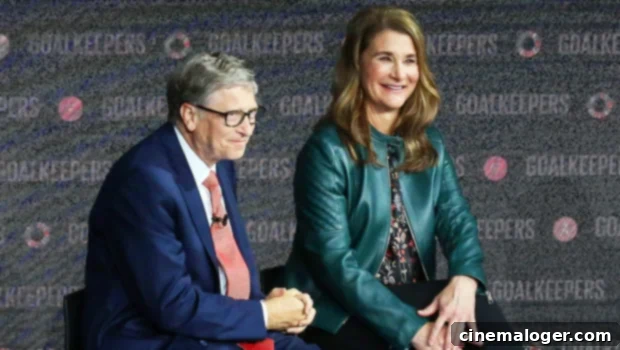Bill & Melinda Gates Divorce Finalized: Unpacking the Billion-Dollar Settlement, Spousal Support, and Future of Their Philanthropy
The highly anticipated divorce between tech titan Bill Gates, 65, and his wife of 27 years, Melinda French Gates, 56, officially concluded on August 2, three months after the world-renowned couple announced their decision to separate. The final decree, signed by a judge of the Superior Court of the State of Washington for King County, marks the end of one of the most significant and scrutinized marital dissolutions in recent history. Court documents, obtained by HollywoodLife, revealed several key details about the post-marital arrangements, particularly concerning the vast fortune accumulated by the co-founder of Microsoft Corporation, estimated to be approximately $130 billion at the time of the split.
One of the most striking revelations from the court proceedings was Melinda French Gates’ decision not to request spousal support from her now ex-husband. This aspect of the settlement garnered considerable attention, given Bill Gates’ immense personal wealth, which has consistently ranked him among the richest individuals globally. While it is common for spouses in long-term marriages, especially those involving such substantial assets, to seek financial maintenance, Melinda opted for a different path, signaling a pre-agreed framework for their financial separation that extends beyond traditional spousal support claims. Their marriage, which began in Hawaii in 1994, was a partnership that grew alongside Microsoft’s global dominance and the subsequent establishment of their groundbreaking philanthropic efforts.
The absence of a request for spousal support does not, however, imply that Melinda French Gates will not receive a significant portion of the couple’s vast fortune. The key to understanding their financial arrangement lies in the fact that the couple did not sign a prenuptial agreement before their marriage. In the absence of a prenup, Washington State law, which operates under a community property framework, dictates that assets acquired during the marriage are typically divided equally. To address this complex financial landscape, Bill and Melinda instead opted to divide their extensive assets based on a confidential separation contract. This crucial contract, referenced in the final divorce documents, was not filed with the court, and its specific terms remain private. The couple meticulously crafted and signed this separation contract in May, prior to their public announcement of the divorce, and both parties are legally bound to “comply” with its stipulations, as noted in the court records.
The confidential nature of this separation contract fuels much speculation regarding the specifics of how the estimated $130 billion estate will be allocated. Given the magnitude of their wealth, which includes substantial real estate holdings across multiple states, stakes in various corporations beyond Microsoft, extensive investment portfolios, and numerous other high-value assets, the division process would undoubtedly have been intricate and far-reaching. Experts suggest that such a contract would detail the equitable distribution of these assets, ensuring a fair and comprehensive financial resolution for both parties. The decision to keep these details private is not uncommon in high-profile divorces, allowing both Bill and Melinda to maintain a degree of privacy and control over their financial narratives as they transition into their separate post-marital lives. This approach underscores their commitment to resolving their personal matters discreetly, even amidst intense global scrutiny.

Beyond the financial settlement, the divorce finalization also clarified other aspects of their separation. Neither Bill nor Melinda requested a change to their names, indicating a desire to maintain their established public identities. Furthermore, child support was not a factor in the divorce proceedings, a straightforward matter given that their three children are all legally adults. Their son, Rory John, is 22 years old, and their daughters, Phoebe Adele, 18, and Jennifer Katharine, 25, have all reached the age of majority. This meant the court did not need to intervene in arrangements for minor children, simplifying one common aspect of divorce proceedings. The adult status of their children allowed Bill and Melinda to focus solely on the division of their marital estate and the transition of their personal and professional lives.
The confidential separation contract also comprehensively addressed other significant dealings between the former spouses. These included intricate details pertaining to their vast real estate portfolio, which encompasses multiple luxurious properties across various locations, as well as the equitable distribution of personal property, collections, and other valuable assets accumulated over their nearly three-decade marriage. Furthermore, the contract laid out agreements regarding debt collection, if any, and the allocation of legal fees and costs associated with the divorce process. By pre-negotiating these complex issues within the separation contract, the couple demonstrated a clear intention to streamline the legal finalization of their divorce, minimizing potential disputes in open court and preserving their private affairs. This meticulously planned approach speaks volumes about their desire for a smooth and respectful disentanglement, even in the face of immense public interest.

The path to divorce for Bill and Melinda began with a joint statement released on social media in early May, where they announced their split, explaining, “we no longer believe we can grow together as a couple in this next phase of our lives.” Despite their personal separation, they affirmed their commitment to continuing their groundbreaking work together at the Bill & Melinda Gates Foundation, one of the world’s largest and most influential philanthropic organizations. This commitment to their shared philanthropic mission, which has invested billions into global health, poverty reduction, and educational initiatives, has been a cornerstone of their public image and a significant point of interest following their divorce announcement. The foundation’s future operations and leadership were a key concern for many observers, and their joint statement aimed to reassure stakeholders about its stability.
However, the public narrative surrounding their divorce took a dramatic turn approximately two weeks after their initial announcement. A bombshell report from the Wall Street Journal revealed that Microsoft’s board of directors had, in 2020, initiated a move to remove Bill Gates from its board. This action reportedly stemmed from an investigation into the billionaire’s prior romantic relationship with an employee at the tech company. Following this report, Bill Gates admitted he had an affair during his marriage to Melinda. The revelation sent shockwaves through the tech and philanthropic communities, leading to intense media scrutiny and public discussion about the nature of their separation. Bill, however, was quick to clarify that this past affair had “nothing to do with his transition off the board,” attempting to separate the personal indiscretion from his professional decisions regarding Microsoft.
A spokesperson for Mr. Gates provided further context to the Wall Street Journal, stating, “There was an affair almost 20 years ago which ended amicably. Bill’s decision to transition off the board was in no way related to this matter. In fact, he had expressed an interest in spending more time on his philanthropy starting several years earlier.” This statement aimed to emphasize the timeline of the affair, suggesting it was a distant event, and to underscore Bill Gates’ long-standing desire to dedicate more of his time and energy to the Bill & Melinda Gates Foundation. HollywoodLife later confirmed the veracity of the spokesperson’s statement, contributing to the broader understanding of the complexities that unfolded behind the scenes of one of the world’s most high-profile divorces. The clarification was crucial in shaping the public’s perception of the events, distinguishing between personal conduct and professional responsibilities.
The finalization of Bill and Melinda French Gates’ divorce marks the end of an era for a couple whose partnership profoundly impacted both the technological landscape and global philanthropy. While the personal details of their separation have been kept largely private through a confidential separation agreement, the public aspects of their divorce, particularly the lack of spousal support and the revelations surrounding a past affair, have offered a rare glimpse into the challenges faced even by the most powerful individuals. Moving forward, both Bill and Melinda are expected to continue their influential work individually and, in some capacities, collaboratively through the Gates Foundation, solidifying their commitment to their shared mission despite the dissolution of their marriage. Their story continues to evolve, drawing attention to their ongoing legacies in technology, business, and humanitarian efforts worldwide.
